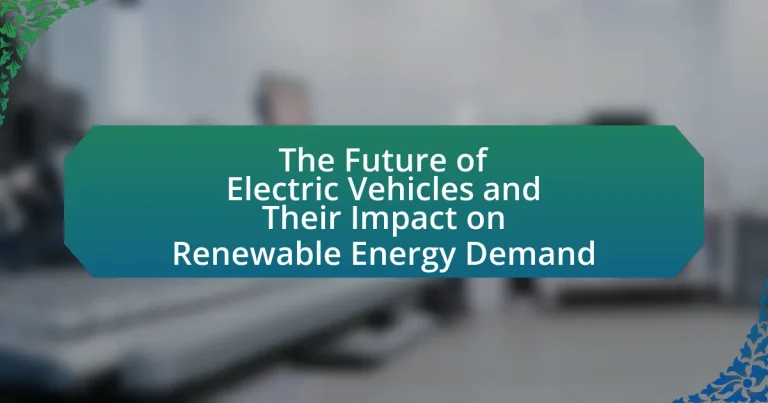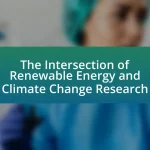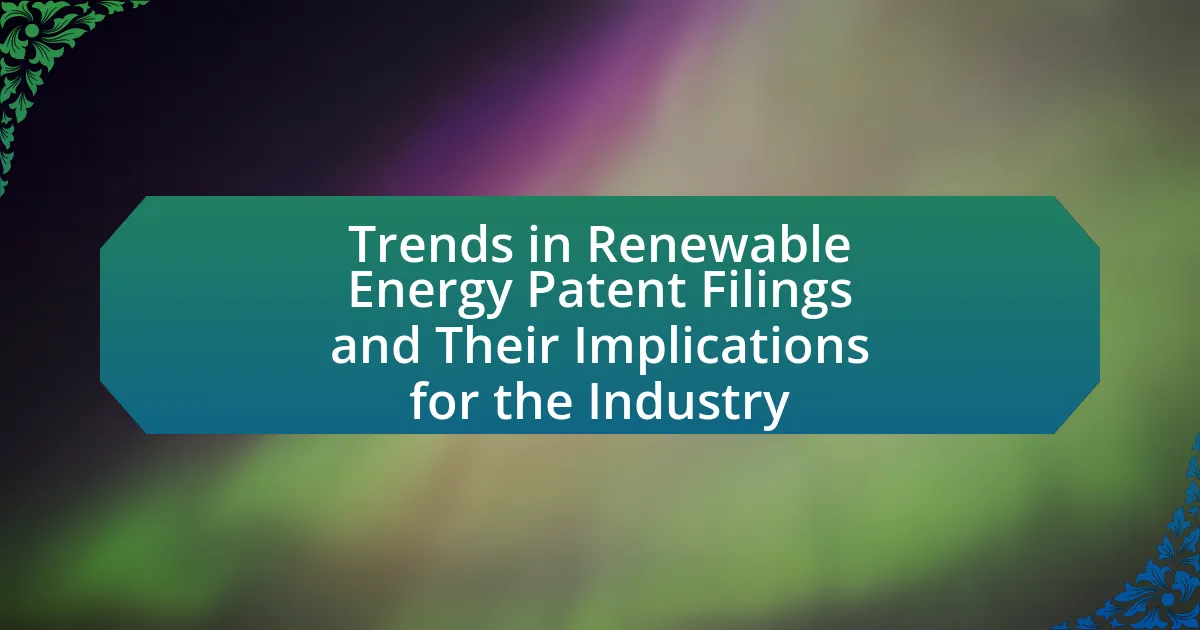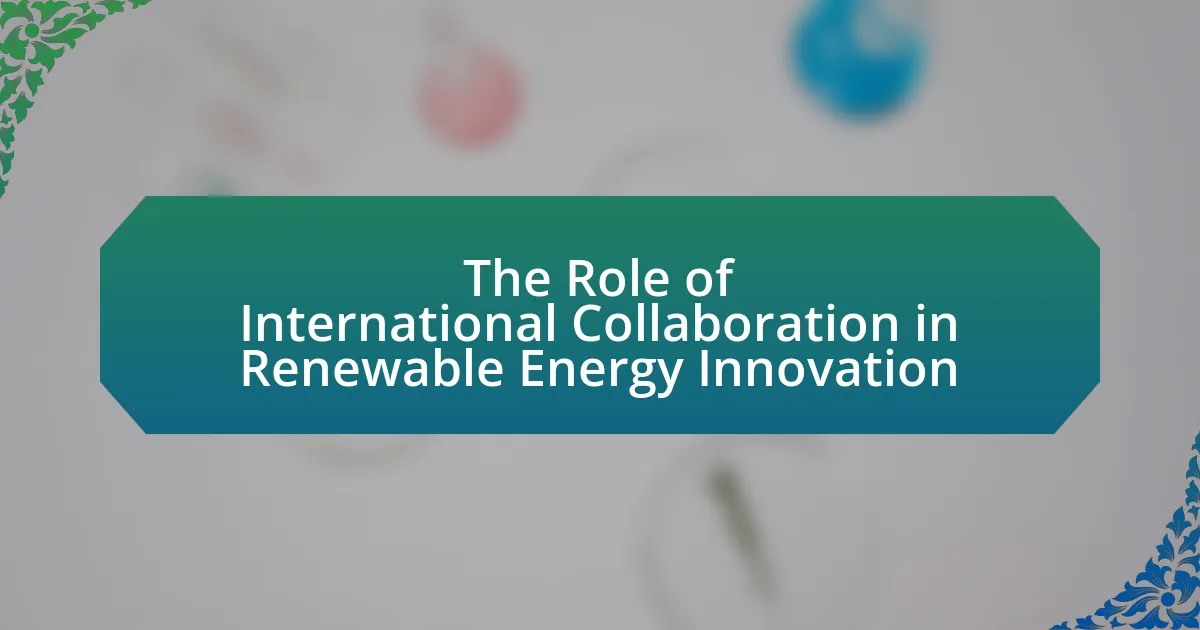The article examines the future of electric vehicles (EVs) and their significant impact on renewable energy demand. As EV adoption accelerates, driven by advancements in battery technology and government incentives, the need for clean energy sources to power these vehicles is expected to rise substantially. Key topics include the evolution of EVs in the automotive market, technological advancements, consumer preferences, and the challenges faced in integrating EVs with renewable energy sources. Additionally, the article discusses the role of regulatory policies, infrastructure requirements, and financial incentives in promoting the adoption of EVs and renewable energy, as well as best practices for consumers to maximize their benefits.
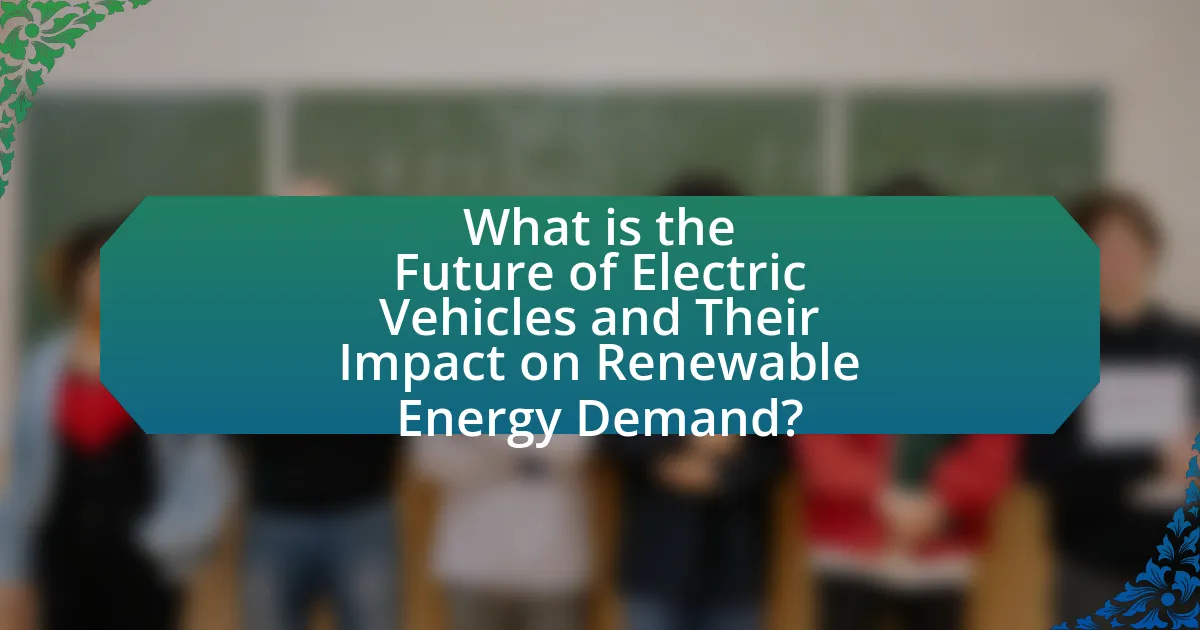
What is the Future of Electric Vehicles and Their Impact on Renewable Energy Demand?
The future of electric vehicles (EVs) is poised to significantly increase the demand for renewable energy. As EV adoption accelerates, driven by advancements in battery technology and government incentives, the need for clean energy sources to power these vehicles will rise. For instance, the International Energy Agency (IEA) projects that the number of electric cars on the road could reach 145 million by 2030, which would require a substantial increase in renewable energy generation to meet charging needs. This shift will likely lead to greater investments in solar, wind, and other renewable technologies, as utilities and energy providers adapt to the growing electricity demand from EVs. Additionally, integrating EVs with smart grid technologies can optimize energy use and further enhance the reliance on renewable sources, creating a more sustainable energy ecosystem.
How are electric vehicles evolving in the automotive market?
Electric vehicles (EVs) are evolving in the automotive market through advancements in battery technology, increased range, and expanded infrastructure. Manufacturers are developing solid-state batteries, which promise higher energy density and faster charging times compared to traditional lithium-ion batteries. For instance, Tesla’s recent innovations have led to models with ranges exceeding 400 miles on a single charge, addressing consumer range anxiety. Additionally, the global charging network is rapidly expanding, with over 1.3 million public charging points available worldwide as of 2023, facilitating easier access for EV users. This evolution is further supported by government incentives and regulations aimed at reducing carbon emissions, driving both consumer adoption and manufacturer investment in electric mobility.
What technological advancements are driving electric vehicle development?
Technological advancements driving electric vehicle development include improvements in battery technology, electric drivetrains, and charging infrastructure. Enhanced lithium-ion batteries, for instance, have increased energy density and reduced costs, making electric vehicles more accessible; the average cost of lithium-ion batteries fell by 89% from 2010 to 2020, according to BloombergNEF. Additionally, advancements in electric drivetrains have led to higher efficiency and performance, with many manufacturers achieving over 90% efficiency in converting electrical energy to vehicle movement. Furthermore, the expansion of fast-charging networks has significantly reduced charging times, with some stations providing up to 80% charge in under 30 minutes, facilitating longer trips and increasing consumer confidence in electric vehicles.
How do consumer preferences influence the future of electric vehicles?
Consumer preferences significantly influence the future of electric vehicles (EVs) by driving demand for features such as sustainability, performance, and technology integration. As consumers increasingly prioritize environmental concerns, the demand for EVs is expected to rise, with a report from the International Energy Agency indicating that global EV sales reached 6.6 million units in 2021, a 108% increase from the previous year. This shift in consumer behavior encourages manufacturers to invest in cleaner technologies and expand their EV offerings, thereby shaping the market landscape. Additionally, preferences for advanced technology, such as autonomous driving and connectivity, further propel innovation in the EV sector, leading to a more competitive and diverse range of electric vehicles in the future.
Why is the demand for renewable energy increasing alongside electric vehicle adoption?
The demand for renewable energy is increasing alongside electric vehicle adoption because electric vehicles require clean energy sources to maximize their environmental benefits. As more consumers and governments prioritize reducing carbon emissions, the shift towards electric vehicles drives the need for renewable energy to power them sustainably. For instance, in 2021, the International Energy Agency reported that electric vehicle sales surged by 108% compared to the previous year, highlighting a growing market that necessitates a corresponding increase in renewable energy production to meet charging demands. This trend is further supported by policies promoting renewable energy investments, which aim to create a sustainable ecosystem for electric vehicles and reduce reliance on fossil fuels.
What role do electric vehicles play in the transition to renewable energy sources?
Electric vehicles (EVs) significantly contribute to the transition to renewable energy sources by reducing reliance on fossil fuels and facilitating the integration of renewable energy into the transportation sector. EVs operate on electricity, which can be generated from renewable sources such as solar, wind, and hydroelectric power, thereby decreasing greenhouse gas emissions associated with traditional gasoline and diesel vehicles. According to the International Energy Agency, the adoption of EVs could lead to a reduction of up to 1.5 gigatons of CO2 emissions by 2030, highlighting their potential impact on climate change mitigation. Additionally, EVs can act as energy storage systems, allowing for the use of excess renewable energy during peak production times, thus enhancing grid stability and efficiency.
How does the growth of electric vehicles affect energy consumption patterns?
The growth of electric vehicles (EVs) significantly alters energy consumption patterns by increasing electricity demand while reducing reliance on fossil fuels. As more consumers adopt EVs, the overall electricity consumption rises, with projections indicating that by 2040, EVs could account for approximately 30% of global electricity demand. This shift leads to a decrease in gasoline and diesel consumption, which historically dominated transportation energy use. Furthermore, the integration of EVs into the grid can facilitate the use of renewable energy sources, as charging can be aligned with periods of high renewable generation, thus promoting a cleaner energy mix. Studies show that widespread EV adoption can enhance grid stability and efficiency, as EVs can serve as energy storage solutions, enabling better management of energy supply and demand.
What challenges do electric vehicles face in relation to renewable energy demand?
Electric vehicles (EVs) face significant challenges in relation to renewable energy demand, primarily due to the intermittent nature of renewable energy sources like solar and wind. This intermittency can lead to mismatches between energy supply and the charging needs of EVs, complicating the integration of EVs into the energy grid. For instance, during peak charging times, renewable energy generation may not be sufficient, necessitating reliance on fossil fuel-based power sources, which undermines the environmental benefits of EVs. Additionally, the current infrastructure for charging stations often lacks the capacity to handle high demand during peak hours, further exacerbating the issue. According to the International Energy Agency, achieving a balance between EV growth and renewable energy supply will require substantial investments in grid modernization and energy storage solutions to ensure a reliable and sustainable energy supply for EVs.
What infrastructure is needed to support electric vehicle growth and renewable energy integration?
To support electric vehicle growth and renewable energy integration, a robust charging infrastructure, smart grid technology, and energy storage systems are essential. Charging infrastructure must include widespread public and private charging stations to accommodate the increasing number of electric vehicles, with a target of 500,000 charging stations in the U.S. by 2030 as outlined by the Biden administration. Smart grid technology enables efficient energy distribution and management, facilitating the integration of renewable energy sources like solar and wind. Energy storage systems, such as batteries, are crucial for storing excess renewable energy and providing power during peak demand times, thereby enhancing grid reliability and supporting electric vehicle charging needs.
How do regulatory policies impact the future of electric vehicles and renewable energy?
Regulatory policies significantly shape the future of electric vehicles (EVs) and renewable energy by establishing standards, incentives, and frameworks that promote their adoption. For instance, government mandates for emissions reductions and fuel efficiency standards compel automakers to invest in EV technology, leading to increased production and innovation. Additionally, financial incentives such as tax credits for EV purchases and subsidies for renewable energy projects lower the cost barrier for consumers and businesses, driving demand. According to the International Energy Agency, countries with strong regulatory frameworks, like Norway, have seen EV market shares exceed 54% in new car sales as of 2021, demonstrating the effectiveness of such policies in accelerating the transition to sustainable transportation and energy sources.
How can the integration of electric vehicles and renewable energy be optimized?
The integration of electric vehicles (EVs) and renewable energy can be optimized through smart grid technology and vehicle-to-grid (V2G) systems. Smart grids enable real-time communication between energy producers and consumers, allowing for efficient energy distribution and management. V2G systems allow EVs to return stored energy back to the grid during peak demand, thus balancing supply and demand effectively. According to a study by the International Energy Agency, integrating V2G technology can enhance grid stability and increase the utilization of renewable energy sources, leading to a reduction in greenhouse gas emissions and improved energy efficiency.
What are the potential economic impacts of electric vehicles on the renewable energy sector?
Electric vehicles (EVs) can significantly boost the renewable energy sector by increasing demand for clean energy sources. As EV adoption rises, the need for charging infrastructure powered by renewable energy, such as solar and wind, grows, leading to investments in these technologies. For instance, a study by the International Renewable Energy Agency (IRENA) indicates that a 30% increase in EVs could lead to a 20% rise in renewable energy generation by 2030. This shift not only enhances energy security but also creates jobs in renewable energy sectors, further stimulating economic growth. Additionally, the integration of EVs with smart grid technologies can optimize energy consumption and reduce costs, reinforcing the economic viability of renewable energy investments.
How can electric vehicles contribute to energy grid stability?
Electric vehicles (EVs) can contribute to energy grid stability by acting as distributed energy resources that provide demand response and energy storage capabilities. When EVs are charged during off-peak hours, they help flatten demand peaks, reducing stress on the grid. Additionally, EVs can discharge stored energy back to the grid during peak demand periods, a process known as vehicle-to-grid (V2G) technology. According to a study by the National Renewable Energy Laboratory, integrating V2G technology could potentially provide up to 10 gigawatts of power to the grid, significantly enhancing stability and reliability. This dual role of EVs as both consumers and suppliers of energy supports the integration of renewable energy sources, further stabilizing the grid.
What financial incentives exist for promoting electric vehicle and renewable energy adoption?
Financial incentives for promoting electric vehicle and renewable energy adoption include tax credits, rebates, grants, and subsidies. For instance, the federal government in the United States offers a tax credit of up to $7,500 for the purchase of new electric vehicles, which encourages consumers to transition to cleaner transportation options. Additionally, many states provide rebates that can further reduce the cost of electric vehicles, making them more accessible. Renewable energy projects often benefit from grants and subsidies, such as the Investment Tax Credit (ITC), which allows for a 26% tax credit for solar energy systems installed before 2023. These financial incentives are designed to lower the upfront costs associated with electric vehicles and renewable energy technologies, thereby accelerating their adoption and contributing to a reduction in greenhouse gas emissions.
What best practices can consumers follow to maximize the benefits of electric vehicles and renewable energy?
Consumers can maximize the benefits of electric vehicles (EVs) and renewable energy by adopting several best practices. First, consumers should charge their EVs during off-peak hours to take advantage of lower electricity rates and reduce strain on the grid. According to the U.S. Department of Energy, charging during these times can save consumers up to 50% on their electricity bills.
Second, utilizing renewable energy sources, such as solar panels, can further enhance the benefits of EVs. By generating their own electricity, consumers can power their vehicles with clean energy, reducing reliance on fossil fuels and lowering greenhouse gas emissions. The National Renewable Energy Laboratory reports that homes with solar panels can offset up to 100% of their energy consumption, including EV charging.
Third, consumers should participate in local incentive programs for EVs and renewable energy installations. Many states offer tax credits, rebates, or grants that can significantly lower the initial costs of purchasing an EV or installing renewable energy systems. For instance, the federal tax credit for electric vehicles can provide up to $7,500, making EV ownership more affordable.
Lastly, consumers can stay informed about advancements in EV technology and renewable energy solutions. Engaging with community programs and educational resources can help consumers make informed decisions that align with their sustainability goals. By following these practices, consumers can effectively enhance their experience with electric vehicles and renewable energy while contributing to a more sustainable future.
